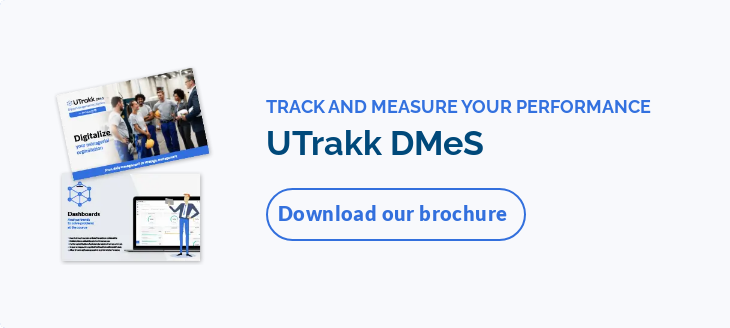What are 5S audits?
5S audits are a systematic assessment method used primarily in industrial and manufacturing sectors to ensure that workspace organization and management practices are applied effectively.
This structured approach is based on the Japanese methodology of the same name (5S method), which comprises the steps Seiri (Sort), Seiton (Set in order), Seiso (Shine), Seiketsu (Standardize) and Shitsuke (Sustain). Focused on continuous improvement, it aims to create an optimized work environment while minimizing waste.
In other words, implementing 5S helps reduce waste, streamline workflows, and enhance operational efficiency, which are crucial for effective quality management. By ensuring that everything is in its place and that the environment is conducive to high-quality work, 5S audits contribute directly to maintaining high standards and improving quality across all work processes.

People in charge of 5S audits
Internal audit team
It is often made up of staff with a good knowledge of operational processes and specific 5S training (quality managers, production supervisors, and floor staff trained as internal auditors).
The internal audit team is responsible for planning and carrying out audits, reporting the results, and monitoring the progress of action plans implemented.
Specialized audit team
External consultants can be engaged for larger companies or those seeking an external perspective. They bring impartiality and expertise that can help better assess the effectiveness of the 5S practices in place.
Frequency of 5S audits
Regular audits
Their frequency may vary according to the company's specific needs and the maturity of its 5S system. These audits are often carried out quarterly or half-yearly to ensure regular monitoring of standards.
One-off audits
In addition to regular audits, one-off audits can be carried out to ensure that 5S practices are continually respected without prior preparation.
7 Steps to carry out a successful 5S audit in your manufacture
1. Prepare and plan
- Definition of objectives: Clarify what the audit aims to achieve, the areas for improvement, and how this fits into the company's overall objectives.
- Forming the audit team: Assemble a team with various skills, including managers, operators, and support staff.
- Planning: Schedule audits and define the work areas to be audited. Evaluation criteria are clearly defined for each 5S "S".
2. Communicate about the 5S audit
- Staff information: Inform all staff of the 5S initiative, the audit objectives, and their role in the process.
- 5S training: Ensure that all employees understand how 5S works and how they can contribute to its implementation.
3. Perform the audit
- Assessment based on 5S criteria: Conduct the audit in the field, using checklists and assessment tools to measure 5S compliance. Each work area is evaluated according to predefined criteria.
- Data collection: Take photos, record observations during the visual inspection, and measure deviations from established standards.
4. Analyze the results
- Identification of strengths and weaknesses: Analyze the results to determine areas of success and those requiring improvement.
- Audit report: Prepare a detailed report summarizing findings, scores, and recommendations for each "S".
5. Create an action plan and implement it
- Action plan development: Define specific corrective actions, assign employees responsibilities, and set implementation deadlines.
- Action implementation: Execute improvements, adjust where necessary, and verify the actions' effectiveness.
6. Monitor for continuous improvement
- Regular assessments: Carry out follow-up audits to ensure improvements are maintained and identify new opportunities for improvement.
- Revision of standards: Update standards and practices as necessary to reflect changes and process improvements.
7. Assess impact and adjust
- Performance measurement: Assess the impact of changes on overall company performance.
- Results-based adjustments: Make adjustments based on performance and employee feedback to improve processes continuously.
How to score a 5S audit
Scoring a 5S audit is crucial for assessing the effectiveness of existing practices and identifying where improvements are needed.
Develop an evaluation grid
Create a specific evaluation grid covering the five 5S areas. Each must be evaluated according to predefined criteria that reflect the company's objectives and expectations.
Define scoring criteria
For each "S", define clear scoring criteria. For example, you could use a scale of 1 to 5, where 1 indicates total non-compliance, and 5 indicates total compliance with established standards.
Ensure these criteria are clearly understood by all those responsible for the audit.
Example of evaluation criteria for Seiri (Sort)
- Decluttering of offices and workspaces
- Clear identification of unnecessary items
- Waste management system is in place
- Temporary storage areas for remaining items
- Sorting procedure is regularly followed
Use standardized checklists
To ensure consistency and objectivity, use standardized checklists for each "S". Each 5S audit checklist should include the points to be assessed and provide space for scoring according to defined criteria.
Carry out the audit
During the audit, managers should observe and score each criterion based on the current state of the area concerned. Taking detailed notes and photos is essential to justify the scores awarded.
Example of scores awarded by the team for Seiri (Sort)
- Decluttering of offices and workspaces: 4
- Clear identification of unnecessary items: 5
- Waste management system is in place: 3
- Temporary storage areas for remaining items: 2
- Sorting procedure is regularly followed: 5
Calculate scores
At the end of the audit, calculate the scores for each "S" by adding the points and dividing by the total number of possible points to obtain a percentage.
This method gives a clear picture of the level of compliance in each area.
Example of score calculation
Seiri score: (4 + 5 + 3 + 2 + 5) / (5 x 5) = 19 / 25 = 0.76
Percentage score: 0.76 x 100 = 76%.
To obtain the overall score for the 5S audit, repeat the process for each area (Seiton, Seiso, Seiketsu, Shitsuke), then average the scores for all areas.
Let's assume that the scores for the other areas are:
- Seiton: 80%
- Seiso: 70%
- Seiketsu: 85
- Shitsuke: 90%
Overall score: (76% + 80% + 70% + 85% + 90%) / 5 = 80.2%
The overall score for the 5S audit is 80.2%. This score reflects the overall effectiveness with which 5S principles are being applied in the organization at the time of the audit.
Analyze results
Examine the scores to identify strengths and weaknesses. A detailed analysis will help you understand where improvements are needed and what corrective action should be taken.
Reporting and feedback
Prepare an audit report that presents scores, observations, and recommendations. Share this report with relevant stakeholders and discuss the results to encourage dialogue and continuous improvement.
Use UTrakk to conduct effective 5S audits
The UTrakk Daily Management System (DMS) facilitates and optimizes every step of the 5S audit – from digitizing the process to analyzing the results – with comprehensive and robust features including a ritual management tool, standardized checklists, actions and opportunities, dashboards, and more.
- Audit process digitalization: Digitalizing the audit process involves transforming manual methods into digital, standardized processes. This includes the creation of consistent, digital checklists that facilitate data collection and analysis directly on the shop floor, while reducing errors and delays due to manual tasks.
- Planning: Planning is essential for effective audits. By planning audits with UTrakk, responsibles can schedule each of these rituals and assign tasks to team members, ensuring that every step of these critical activities is completed. Periodic planning and execution of 5S audits also enable regular adjustments to the process, for greater efficiency and continuous improvement.
- Corrective action management: Problems or opportunities for improvement identified during a 5S audit require corrective actions. UTrakk DMS simplifies the management of these actions by enabling the creation of detailed tasks or projects from an audit ritual, and the follow-up of deadlines with designated responsibles. This ensures that actions and projects stay on track, and that problems are solved in due time.
- Dashboards and analysis: The DMS solution’s advanced dashboard feature offers in-depth trend analysis, enabling people in charge of the 5S audits to quickly spot any variances from predefined standards. These dashboards provide real-time, valuable information helping managers and leaders make informed decisions and adjust strategies to meet and exceed standards.

Tips and best practices for successful 5S audits
Practice training and awareness
- Regularly educate employees on 5S principles and practices to ensure consistent understanding and commitment. Train leaders within the team who can serve as 5S experts, motivating and guiding other workers.
- Create reference materials to help employees maintain 5S standards daily. For example, this could be a 5S manual or guide detailing standard operating procedures (SOPs), expectations, and good practices. Make sure that this document is easily accessible to everyone and that it is regularly updated.
Embrace digital tools and technologies
- In addition to standardized checklists, software or mobile applications such as UTrakk can simplify data collection and analysis during the audit.
- Take photos before and after audits to visualize progress and identify areas requiring further attention.
Communicate with transparency and openess
- Share audit results with the whole team, then openly discuss successes and areas for improvement.
- Use operational dashboards to display audit results and progress.
Set realistic standards
- Develop ambitious and achievable standards adapted to your production site's capabilities and culture.
- Review these standards regularly to ensure they remain both relevant and motivating.
Use signage and visualization
- Implement clear signage and visual cues such as floor markings, red tags, or color coding to help keep workstations well organized and clean.
Exercise flexibility and iterative improvement
- Be flexible in applying 5S practices and open to adapting them according to feedback and audit results.
- Favor an iterative approach that enables you to continually refine processes and practices in response to internal and external changes.
UTrakk optimizes 5S audits for improved industrial performance
Much more than a simple compliance check, the 5S audit is an essential dynamic method for plants seeking to create an efficient work environment, optimize productivity, and reach operational excellence. Thanks to this process, they can maintain high standards of cleanliness, order, and discipline and cultivate a sustainable culture of continuous improvement.
Using UTrakk to support the 5S methodology and audits highlights the importance of technology in manufacturing management practices. Not only does this comprehensive platform facilitate the standardization, management, and monitoring of audits, but it also improves communication and collaboration of teams working on these activities, fostering permanent implementation of continuous improvement initiatives.
So 5S auditing, supported by robust technological solutions, becomes a strategic lever for the company's transformation and long-term success.











